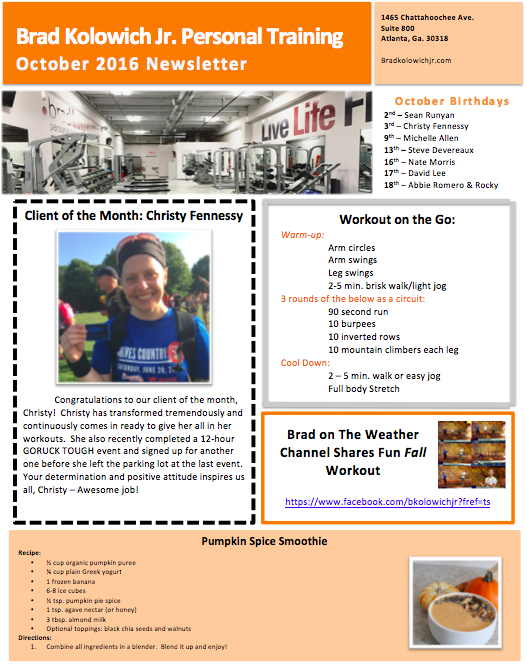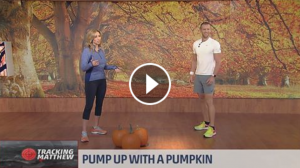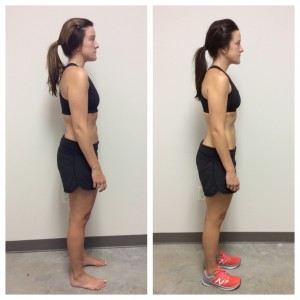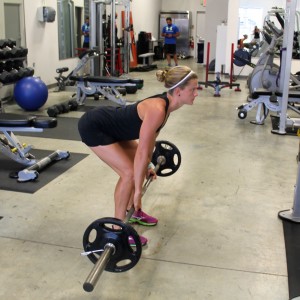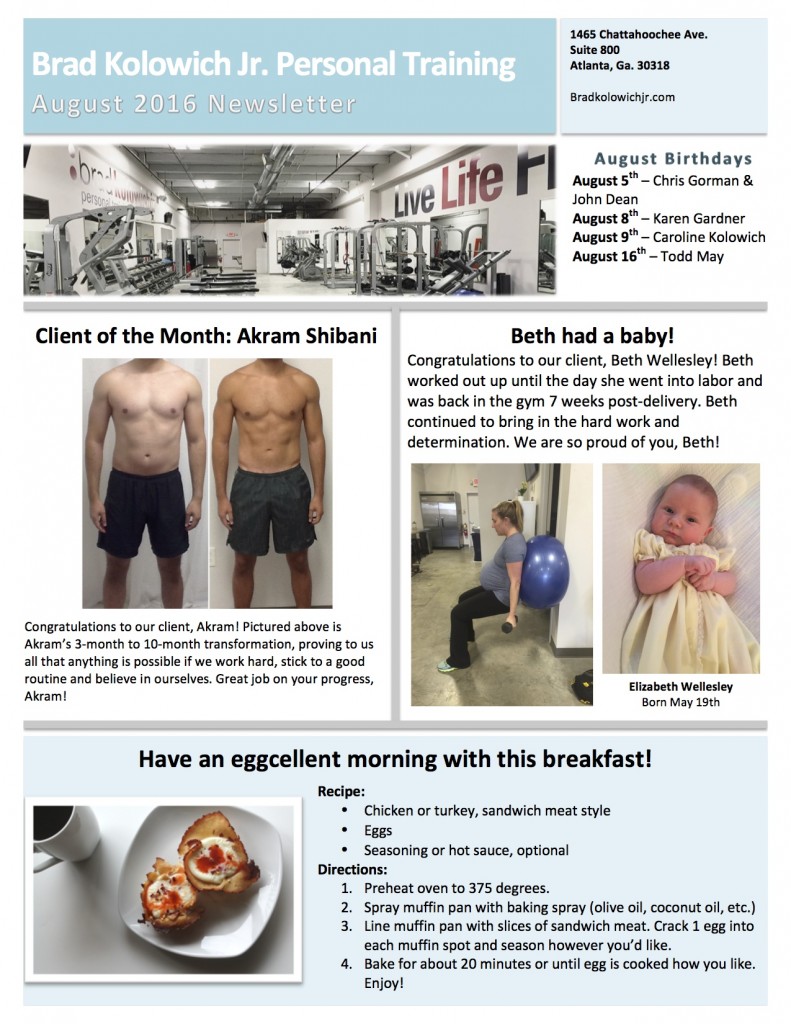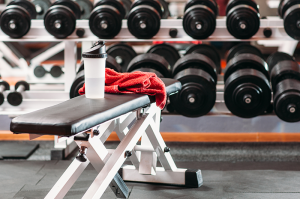Posts
Happy October, everyone!
Join our very own Atlanta Personal Trainer, Brad Kolowich Jr on the Weather Channel for a fun fall workout!
Awesome job, Brad, we are all so proud of you! Your pumpkin workout was a perfect way to make exercising fun and exciting in the fall!
By Dr. Mercola
While multiple companies manufacture and market “new and improved” FMCGs — fast- moving consumer goods — that we use every day, such as soap, toothpaste, deodorant and body lotion, one of the best and most natural products has been right under our noses, so to speak.
Coconut oil has a pleasant scent, and besides being very economical, it’s an amazingly versatile and therapeutic substance. Since the mid-1990s, roughly, coconut oil for a number of applications, such as cleansing, deodorizing and healing, has been growing on the larger population.
Questions like “Where does coconut oil actually come from?” and “What does it smell like?” are apropos. Coconut oil, like butter, is a solid substance, melting to a liquid form when it reaches about 76 degrees.
Insoluble at room temperature, it takes on a creamy consistency when blended with water using a whisk. If not treated to processes such as bleaching, refining or deodorizing, coconut oil exudes the mild fragrance you would expect — like coconut.
2 Kinds of Coconut Oil — Commercial Grade and Virgin
The relatively recent interest in the many uses of coconut oil also elicits questions regarding its production. There are two basic types: Commercial-grade and virgin coconut oil.
Commercial grade coconut oil — This product is made from copra, which is the dried meat of the coconut. It’s usually smoke-, sun- or kiln-dried or a combination of the three. But when standard copra is used to make coconut oil, it’s not sterile and therefore unsuitable for human consumption.
It’s “purified” or refined through a process known as RBD — refined, bleached and deodorized. According to Coconutdiet.com:1
“High heat is used to deodorize the oil, and the oil is typically filtered through (bleaching) clays to remove impurities. Sodium hydroxide is generally used to remove free fatty acids and prolong shelf life.
This is the most common way to mass-produce coconut oil. The older way of producing refined coconut oil was through physical/mechanical refining. More modern methods also use chemical solvents to extract all the oil from the copra for higher yields.”
Virgin coconut oil — In comparison, like olive oil, coconut oil is best when “first-pressed” and “virgin.” Like pressing a teabag that’s been steeping in boiled water a few minutes, the first water released will contain the most actual extracts.
The second time it’s pressed, as in the teabag analogy, the result isn’t as concentrated. Coconutdiet.com continues:
“Virgin Coconut Oil can only be achieved by using fresh coconut meat or what is called non-copra. Chemicals and high heating are not used in further refining, since the natural, pure coconut oil is very stable with a shelf life of several years.
There are currently two main processes of manufacturing Virgin Coconut Oil:
- Quick drying of fresh coconut meat which is then used to press out the oil. Using this method, minimal heat is used to quick dry the coconut meat, and the oil is then pressed out via mechanical means.
- Wet-milling. With this method, the oil is extracted from fresh coconut meat without drying first. ‘Coconut milk’ is expressed first by pressing.
The oil is then further separated from the water. Methods which can be used to separate the oil from the water include boiling, fermentation, refrigeration, enzymes and mechanical centrifuge.”
Why Keep Coconut Oil in the Bathroom?
Raw, organic coconut oil, besides being good enough to eat (which we’ll discuss in a minute) has a plethora of benefits apart from actual ingestion. Here’s a list of 15 benefits of coconut oil, in no particular order:
1. Smooth shave — If you’ve been plagued by red, irritated and razor-burned skin after shaving, coconut oil is both soothing and antibacterial.
2. Rash recovery — Other rash problems from diaper rash to mild allergic reactions can be remedied using coconut oil. Propylene glycol is one chemical found in commercial moisturizers that can cause skin irritation and dermatitis.
3. Lip balm — Use coconut oil to moisturize, nourish and hydrate chapped lips without inadvertently eating endocrine disruptors.
A study on the metal content in lip balm revealed lead, aluminum, cadmium, chromium and manganese in high concentrations, some associated with reproductive, developmental or other adverse health effects.2
4. Facial cleanser — Effective as a face wash, mixing equal parts coconut oil and castor oil is known as oil cleansing. Massage it into your skin and remove gently with a warm washcloth.
Ninety percent of the body washes and cleansers you buy contain harmful chemicals such as sodium lauryl sulfate or sodium laureth sulfate, which, in combination with other chemicals, can form cancer-causing nitrosamines.3Coconut oil can even improve acne.
5. Makeup remover — Not only can you cleanse your face, you can remove use it as a natural makeup remover — even stubborn mascara and eyeliner.
6. Night cream — While you may not want to use coconut oil under makeup, applying it lightly before bed will hydrate your skin because its fatty acids form a natural emollient. If the skin around your nails is hard and peeling, treat your cuticles to a soothing coconut oil rub to keep them soft.
7. Deodorant — A tiny dab of coconut mixed, if you desire, with an essential oil such as lavender is very effective — so much better than the antiperspirants containing aluminum, which is linked to Alzheimer’s.
Another deodorant recipe combines 3 tablespoons each of coconut oil, arrowroot powder (or cornstarch) and baking soda.
8. Foot fungus fighter — Because it’s antimicrobial and antibacterial, coconut is very effective in combating athlete’s foot. Rub it on the bottoms of your feet after every shower.
Antiviral, antibacterial and antifungal compounds in coconut oil have been shown to inactivate microorganisms such as bacteria, yeast and fungi.4
9. Soothing bath — As an alternative to bubble baths that may induce urinary tract infections, especially in children, drop a dollop of coconut oil in your bath with a few essential oils. It’s both moisturizing and helps kill bacteria.
10. Body scrub — Combining equal parts coconut oil with sea salt, sugar or baking soda to make a homemade scrub softens, smoothes and moisturizes your skin.
11. Body lotion — Moisturizers you buy at the store typically contain harmful chemicals such as aluminum, phthalates, parabens, formaldehyde and propylene glycol.5 Coconut is a fragrant, moisturizing alternative containing none of these.
12. Toothpaste — To combat tooth decay and even whiten teeth, make a DIY coconut oil toothpaste by mixing 1 teaspoon with 1/2 teaspoon baking soda and 2 drops of peppermint essential oil. Just brush as usual.
13. Oil pulling — An oral rinse works much like a mouthwash, only you shouldn’t gargle with it. As you swish vigorously for five to 15 minutes, it penetrates the soft tissue between your gums and “pulls out” bacteria that causes cavities, plaque and bad breath.
14. When applied to infected cuts or wounds, coconut oil develops a layer of naturally protective chemicals that also keep out dust, fungi, bacteria and viruses. Applied to bruises, it speeds up the healing process in damaged tissues.
15. Frizz fighter — People with hair that tends to frizz often turn to silicone- or alcohol-based gels and mousses, which coat the hair, prevent it from absorbing moisture and dries out the hair shaft. Just a few drops of coconut oil are all you need for a natural hair conditioner for smooth, silky shine.
Healing Properties of Coconut Oil
Virgin coconut oil has been described as having a “haunting, nutty, vanilla flavor (and) even milder and richer-tasting than butter.” A New York Times article noted that coconut oil, while once demonized by the “all saturated fats are bad for you” camp, has now become accepted:
“The main saturated fat in coconut oil is lauric acid, a medium-chain fatty acid. Lauric acid increases levels of good HDL, or high-density lipoprotein, and bad LDL, or low-density lipoprotein, in the blood, but is not thought to negatively affect the overall ratio of the two.
… Any number of health claims have been made for lauric acid. According to proponents, it’s a wonder substance with possible antibacterial, antimicrobial, antiviral properties that could also, in theory, combat H.I.V., clear up acne and speed up your metabolism.”6
Even applied topically, coconut oil has healing properties. One interesting factoid is that while antiperspirants containing aluminum are associated with Alzheimer’s, coconut oil actually prevents it because of the medium-chain fatty acids (MCFA) that are easily absorbed and metabolized by the liver and can convert to ketones. One study noted:
“Ketone bodies are an important alternative energy source in the brain, and may be beneficial to people developing or already with memory impairment, as in Alzheimer’s disease (AD) … (It may also) be beneficial in the treatment of obesity, dyslipidaemia, elevated LDL, insulin resistance and hypertension — these are the risk factors for (heart disease) and type 2 diabetes, and also for AD.”7
Alzheimer’s is projected to affect 1 in 4 Americans in the next generation, rivaling obesity and diabetes, but evidence suggests that ketone bodies in coconut oil may help restore and renew neurons and nerve function in your brain, even after damage has set in.
Unhealthy Alternatives to Coconut Oil
Regarding coconut oil in the kitchen, even as a household cleaner, there are a few points to consider:
• Virgin coconut oil has a smoke point of 350 degrees, so for cooking, it’s best used at lower temperatures. Olive oil overcooks even as low as 250 degrees, which may cause oxidization, doing your body more harm than good.
• You can substitute coconut oil for butter or olive oil, and most definitely instead of so-called vegetable oils. Here’s why:
Multiple studies reveal coconut oil to impart amazing benefits when used in nutritional applications. One of the most dramatic changes you can make in your health will be to replace the so-called “healthy” vegetable, soy, corn and cottonseed oils such as canola when sautéing food or baking cake or cookies.
It’s interesting to note that Polynesian populations, who’ve been using full-fat coconut oil as a diet staple for untold generations, have no heart disease to speak of. Why? It’s a direct contradiction to what conventional medicine touted for a few decades, that saturated fats are bad for you, and will lead to obesity, high cholesterol levels, heart disease and Alzheimer’s.
The truth is, saturated fat like that of coconut oil and olive oil is natural, not the concocted substances created in a laboratory using methods like hydrogenation and partial hydrogenation that convert polyunsaturated fatty acids to trans fats. Vegetable and seed oils undergo the double whammy of hydrogen atoms and high heat, creating a cheaper oil with a long shelf life that’s very bad for your health.
Further, when vegetable oils are heated to a high temperature, the chemical compounds break down, get “stuck” in your cells, oxidize and create dangerous free radicals that lead to disease, including heart disease and cancer. Here’s a timeless article on the type of oil you should cook with.
Adapted from:
http://articles.mercola.com/sites/articles/archive/2016/09/26/coconut-oil-benefits.aspx
Trainer Spotlight: Jonathan Kolowich
Jonathan’s favorite exercise: burpees
Why Jonathan loves burpees:
- “Because not only will burpees turn you into an athlete, they’ll also scorch fat and get you conditioned. Burpees involve agility, balance, coordination, and total body strength; and most importantly, they are just as mental as physical. Mental toughness is key in everything in life!”
Pictured below: Jonathan performing the burpee.
LIVE LIFE FIT
CLIENT OF THE MONTH
Paige Crawford
September 2016
Cincinnati native Paige Crawford, 26, moved with her fiancé (soon to be husband) to Atlanta in July 2015. Prior to moving, Paige visited the studio and consulted with Mandy to get a solid nutrition plan and set long-term and short-term fitness goals with the end goal being wedding ready for her September 17th nuptials! Paige has set weight loss, body composition and strength and endurance goals this past year. She has lost more than 18 total inches (4 in the waist) and over 14 pounds while gaining lean muscle mass and drastically decreasing her body fat. In addition to her weight loss, Paige set a goal to complete her first Peachtree Road Race and has a new time goal for an upcoming ½ marathon in December. She is also the current studio record holder for the V-Max and 500m row.
Paige’s dedication to setting goals and bettering her health and fitness is unbelievably inspiring! Thanks Paige for filling the studio with your warm smile, positive attitude, caring personality and drive to succeed!
Please join us in wishing Paige congrats on her success in and out of the gym and best wishes on her special day and upcoming marriage!
Happy September, everyone!
Continue believing in yourselves, working hard and being the best version of you!
Trainer Spotlight: Mandy Malool
Mandy’s favorite exercise: Deadlift
Why Mandy loves the deadlift:
- Minimal equipment required
- Works more muscles simultaneously than any other movement
- Builds core stability
- Helps increase cardiovascular fitness
- Has real life application
- The main muscle group focus is on the hamstrings, glutes and lower back. Who doesn’t want to ensure they are looking good from the back as well as the front?!?!
Pictured Below: Mandy performing the deadlift.
Happy August, Everyone!
We are excited to be bringing monthly newsletters back into the mix here at the studio. Through our monthly newsletters we will be sharing exciting events and news occurring at the studio as well as in our clients’ lives. If you are a client and have something big coming up in future months please keep us posted and we are happy to share in our studio newsletter!
We hope you all have an awesome August and continue to work hard to reach your goals and live the life you have always wanted to live. YOU can do whatever you set your mind to and YOU deserve to be happy; never forget that.
“In order to succeed we must first believe that we can.”
Best,
Caroline Kolowich
As personal trainers clients often ask, “Should I be lifting heavy weight? And, if I do will lifting heavy make me bulky?” The short answer is yes and no! If this has you curious, check out the article below by ACE fitness.
Why you should be lifting heavy
Insanity is often described as doing the same thing over and over, yet expecting different results. This definition could apply to many traditional fitness enthusiasts, who have followed the same workout program for years and wonder why they have stopped experiencing results.
The general adaptation syndrome describes how the human body responds to an exercise stimulus. There is the shock phase, when the exercise stimulus is first applied. This is followed by an adaptation phase of approximately eight to 12 weeks, where the body experiences its greatest response to the exercise stimulus. This leads to the exhaustion phase, when the exercise program stops having the desired effect. This is the basic science behind periodization, which is the practice of adjusting workout intensity on a regular, systematic basis to avoid plateaus.
One sure way to break through a plateau is to change some or all of the variables in the workout program. These variables include: exercise selection, intensity, repetitions, sets, rest interval, tempo (speed of movement) and frequency (the number of exercise sessions in a specific period of time). To stimulate almost immediate changes in your body, increase the amount of weight (thereby increasing the intensity) you use in your workouts. If you find yourself not making any gains or simply want a different exercise program, here are six ways using heavy weights can help you make the changes you want to see in your body.
1. Lifting heavy can cause muscles to grow.
Heavy resistance can recruit and engage more of the type II muscle fibers responsible for generating muscle force. When you lift a heavy weight, you may feel your muscles shaking. This is because your nervous system is working to engage more motor units and muscle fibers to produce the force required to move a weight. Type II muscle fibers are generally responsible for the size and definition of a muscle, so activating more of these fibers can lead help provide immediate results.
2. Lifting heavy improves intramuscular coordination, which is important for improving overall strength.
Intermuscular coordination is the ability of a number of different sections of muscle to work together to produce a movement. Intramuscular coordination is the ability of the fibers that comprise a particular muscle to work together to generate a force. Because it requires more force to contract a muscle, using a heavy resistance can improve the intramuscular coordination in a specific section of muscle, which will also help you become more efficient at generating strength.
3. Lifting heavy can help muscles get stronger without getting bigger.
Sarcoplasmic hypertrophy describes how the sarcoplasm of a muscle increases in size as a result of lifting weights at a moderate to high intensity for a higher number of repetitions (e.g., 10 to 15). Myofibrillar hypertrophy describes how muscle fibers become thicker and denser in response to strength training. Using heavy weights focuses on myofibrillar hypertrophy, resulting in muscle that is thicker and stronger, but not necessarily larger. When lifting an optimal amount of heavy resistance, you should only be able to perform five or fewer repetitions while maintaining good form.
4. Lifting heavy weights can help reduce your biological age.
If you’re over the age of 35, you should definitely be using extremely heavy resistance two to four times a week for periods of four to eight weeks at a time. When adult males hit their mid-30s, they will naturally produce less testosterone unless there is a stimulus that causes the body to produce it. Testosterone is a steroid hormone and is responsible for repairing damaged muscle fibers, which can increase the size and strength output of a muscle. Heavy resistance training is one type of stimulus that can cause males to produce testosterone and help increase bone density, both of which are important markers of biological age. Heavy resistance training can also help women over the age of 35 increase their levels of growth hormone, which is important for developing lean muscle and burning fat.
5. Lifting heavy can help increase your resting metabolism.
One pound of skeletal muscle expends approximately 5 to 7 calories a day at rest. Adding 5 to 7 pounds of muscle can increase your resting metabolism (how efficiently your body produces and uses energy) up to 50 calories a day. This might not sound like a lot, but over the course of a year that is a difference of approximately two-thirds of a pound of fat that you can burn while doing absolutely nothing.
6. Lifting heavy stuff makes you look really cool.
Which gives you bragging rights amongst your friends. The downside is that you will have more requests to help friends or family move furniture, but that’s just the price you have to pay for being ridiculously strong.
Using heavier resistance can be intimidating, because it is a lot harder and the applied force will cause muscle damage. (This is one of the ways that muscles grow; to learn more about muscle growth click here). One side effect of lifting heavy is delayed onset muscle soreness, or DOMS. If you have ever felt DOMS, you know how uncomfortable it can be. While it seems counterintuitive to perform light activity when you’re sore, it can help you recover quicker, which will enable you to do the higher volume of exercise necessary for building muscle and making changes in the body.
Machine training can be the safest approach for using extremely heavy weights. For best results, plan on using weights that make five repetitions incredibly challenging (you should not be able to do a sixth rep) and change your program after 10 or 12 weeks so that you’re changing the stimulus to your body. If you want to make sure that you get the best results from your time in the gym, considering hiring an Atlanta Personal Trainer to help adjust your program so that you are safe when increasing the amount of resistance you use.
Adapted from:
http://www.acefitness.org/acefit/healthy-living-article/60/6002/why-you-should-be-lifting-heavy
Summer eating doesn’t have to be stressful. In fact, you can enjoy the sun, sand, heat and treats without adding to your waistline you worked hard for. Here is a list of common nutrition mistakes that most of us are guilty of making at times, and easy ways to fix them so you don’t have to stress this summer:
1. The mistake: Eating salty snacks
The problem: Salty snacks (think processed snack foods, particularly those in packages such as chips, pretzels, cookies, etc.,) cause bloat as your body retains water to help to dilute the salt. The result is an unpleasant swelling in your belly, face and extremities.
The fix: Swap chips, pretzels and other snack foods for a satisfying bite that doesn’t come in a package. Think crunchy veggies and crisp sliced apples. Choose a lower-calorie dip such as hummus and, whenever possible, choose low-sodium varieties. Or try Greek Yogurt Veggie Dip for veggies. Consider dipping apples in yogurt or in a dollop of nut butter, or munch on a single handful of crunchy almonds with the apple slices. Try roasted chickpeas or air-popped popcorn or frozen grapes with an ounce of low-fat cheese.
2. The mistake: Drinking too much alcohol
The problem: Beach vacations and cruises tend to provide many opportunities to indulge in alcohol, especially sugary drinks such as margaritas and piña coladas. But one seemingly innocent 10-ounce margarita could set you back more than 500 calories, nearly a third of the total amount of calories many women who are hoping to lose some weight should consume in an entire day. And tropical drinks often have similar calorie counts. Alcohol also tends to make you feel hungrier, thirstier and less concerned about what you’re eating. This is a triple whammy that can make you quickly pack on the pounds.
The fix: First, start with a plan. Before you start drinking, decide exactly how many alcoholic drinks you’ll have per day. Ideally, women should aim for one drink per day, and men should aim for no more than two. Simply setting a limit can help prevent you from overindulging. To help you to stick to your limit, start with a calorie-free beverage such as seltzer, and then alternate alcoholic beverages with non-caloric ones. Also, try to eat a bit lighter, healthier meals throughout the day to balance out the added calories from the alcohol.
3. The mistake: Indulging in too many sweet treats
The problem: Sweet treats are typically packed with calories and are often high in fat, as well. And an equally large problem is that sweets don’t keep you full, while giving you an energy rush followed by a crash. Energy dips often result the need for a quick pick-me up and an increased craving for even more sweets, so you end up overeating, often on junk food.
The fix: Take advantage of naturally occurring sweets to satisfy your sweet cravings. Naturally sweet foods without added sugar (think: fruits and treats made with them) are typically much lower in calories than those with added sweeteners. Plus, sweets from fruits are packed with nutrients. As veggie-loving registered dietitians who have a sweet tooth that we work hard to keep in check, we’re all too familiar with the temptation to cool off with cold, refreshing sweet treats such as ice cream, frozen yogurt and slushes. Having alternative fixes is what saves us from getting in over our heads. Blended frozen fruit or combined with yogurt or nut milks work wonders. If you’re feeling especially motivated, try cooling off with a large glass of fruit-infused water. Otherwise, a fresh fruit smoothie including a cup of berries, yogurt and add-ins such as cocoa, cinnamon or ginger can turn the flavor up a notch.
4. The mistake: Indulging in too many sweet treats
The problem: Because you sweat a bit more in the warmer months, you need to be mindful to replace the lost water. When you don’t properly rehydrate, you may feel lethargic, as water is needed to create energy. You also mistake thirst for hunger and overeat when you really just need a glass of water.
The fix: Be sure to eat plenty of veggies (they hydrate you) and aim to drink roughly half your body weight, in ounces—and even more if you’re spending time outside. So, if you weigh 150 pounds, aim to drink about 75 ounces of water daily. The good news is if you aren’t a fan of water, a little bit of flavor from fruits or veggies can add both variety and some extra vitamins as well.
5. The mistake: Crash dieting
The problem: Crash diets provide far too few calories to maintain adequate energy levels and too few nutrients for good health, so they typically create fatigue, grogginess and crankiness after the first few days. Plus, most crash diets backfire when they’re over, creating a quick rebound to a higher weight than before the diet started. If crash diets are your jam and your go-to for looking “swimsuit ready,” it’s time to try something new.
The fix: Focus on eating healthy, well-balanced meals by filling about half your plate with vegetables and rounding out one-quarter of your plate with wholesome carbs such as fruits and whole grains, and the other quarter with lean protein such as fish, pulses (legumes), and low-fat dairy or other calcium-rich foods. This way you’ll weed out the foods that aren’t good for health and that pack on pounds, while consuming a lower-calorie diet that fills you with health-promoting nutrients.
Adapted from: www.acefitness.org/blog/5989/5-nutrition-mistakes-to-avoid-this-summer
info@bradkolowichjr.com
KoloFit Training Studio
1465 Chattahoochee Ave.
Suite 800
Atlanta, Ga. 30318

